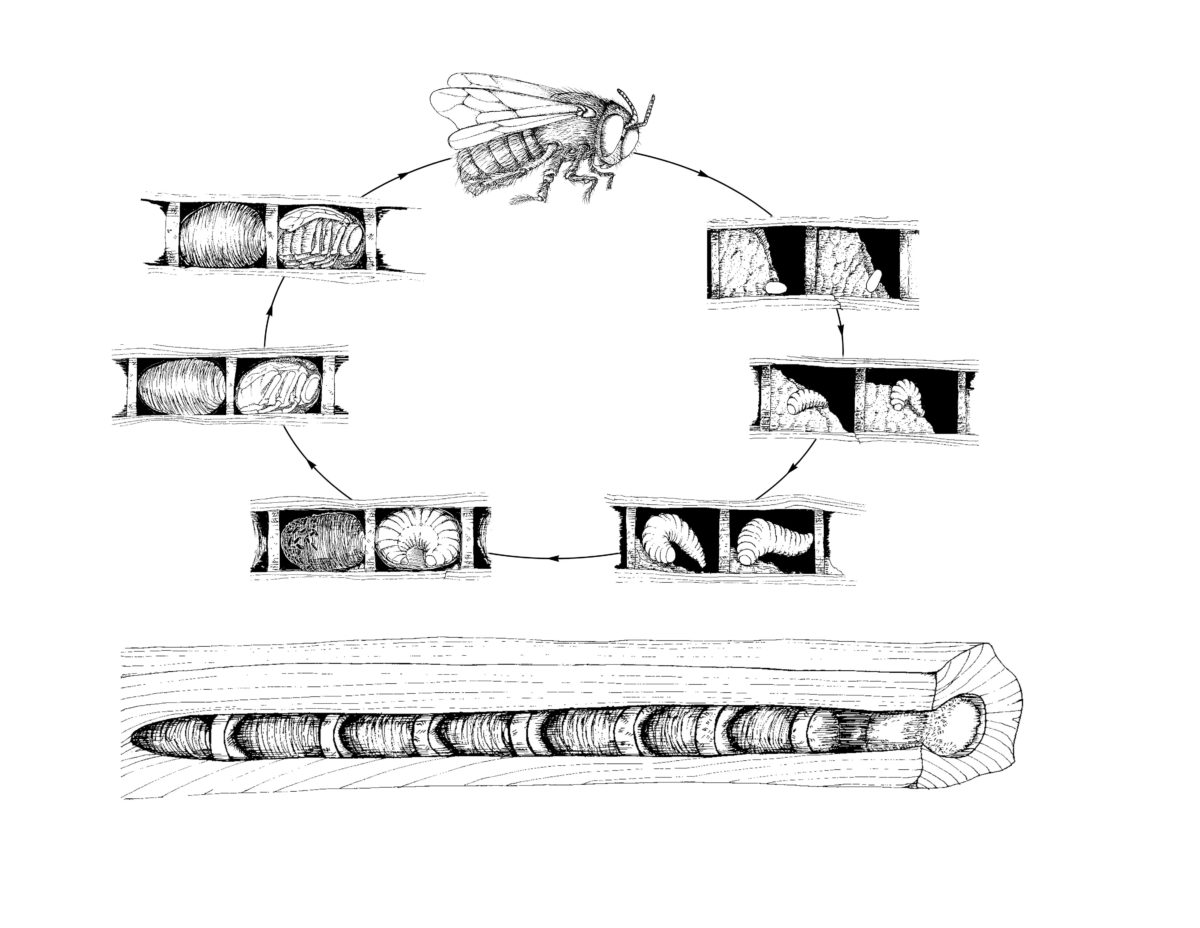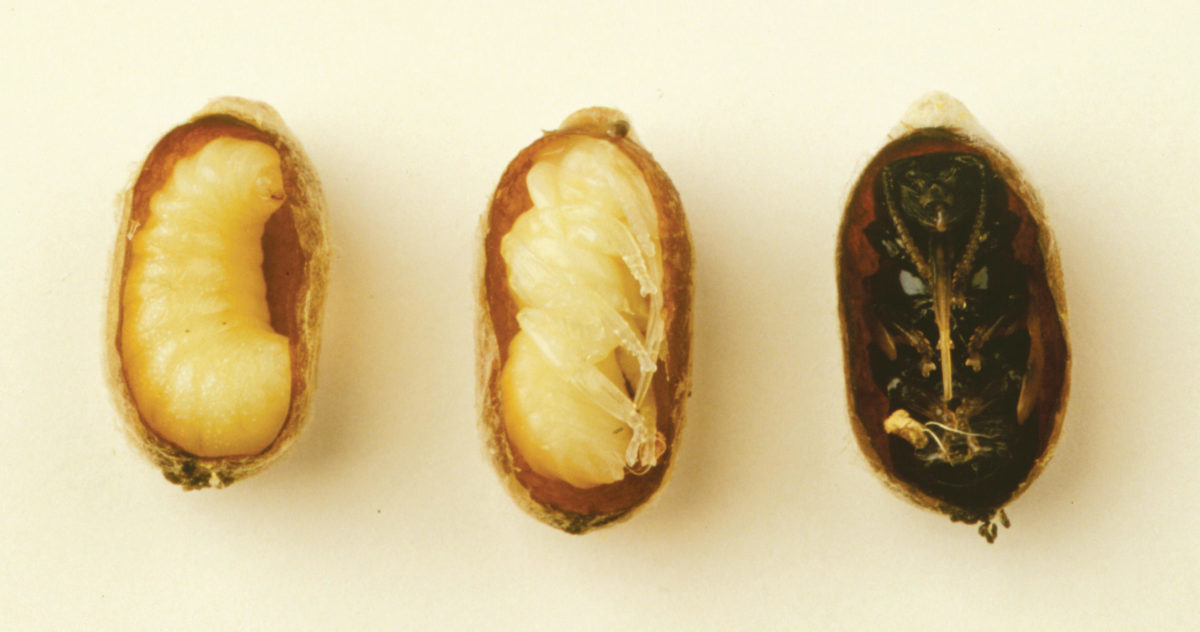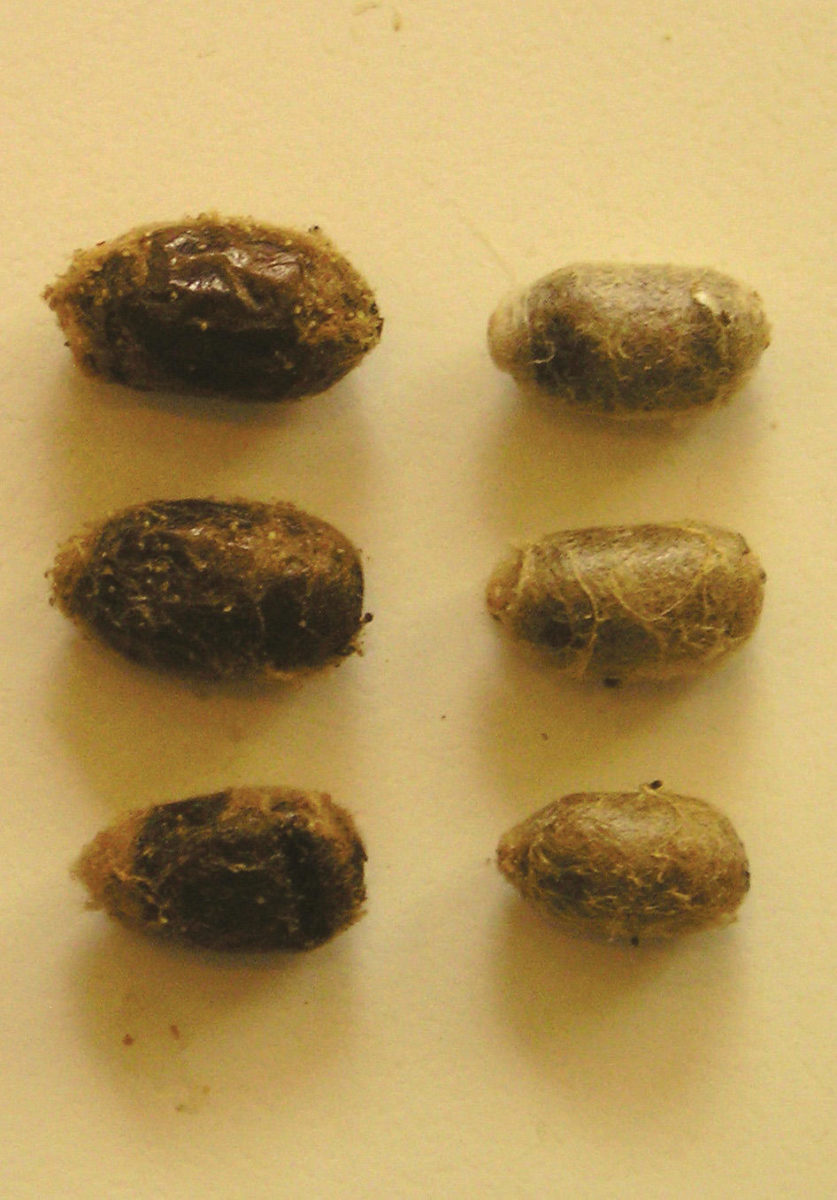
Osmia are tunnel-nesting insects (Figure 6.5). In the wild they nest beneath rock or bark crevices, in the hollow stems of pithy twigs, or in tunnels formed by wood-boring insects. A lack of nesting sites of this type limits the size of wild populations. Management systems exploit this nesting behavior by providing artificial nests constructed of blocks of wood drilled with multiple holes, bundles of cardboard straws, or sections of reed and bamboo. In the absence of suitable nest tunnels, some Osmia will construct amorphous mud structures within which to lay eggs.
When searching for a suitable nest site, a female bee may repeatedly enter and inspect numerous cavities. Tunnel depth, diameter, and material all influence the ratio of male-to-female eggs. After selecting a nest hole, she will then fly in a zigzag pattern in front of the nest entrance, memorizing its exact location. During this orientation flight, the bee memorizes adjacent visual landmarks that help her locate the nest later. It is also believed that female Osmia mark the nests they select with a pheromone to warn other bees that the nest is in use, and to identify the entrance later. After memorizing the location, the bee will be disoriented if the nest is moved—often causing her to completely abandon it. Prior to actual nest construction the female will also clean the tunnel of any dust or refuse. This behavior is occasionally observed even when extremely clean nest tubes are provided, and may be equivalent to the broody nesting behaviors observed in birds.
After memorizing the tunnel, the bee will then fly off in search of suitable materials to begin nest construction. Osmia construct the inner nest cavities with mud gathered in their jaws, literally building tiny cement walls—hence the common term “mason bees.” The mud they prefer is soft and damp with a high clay content that can be molded and shaped without easily crumbling. Mason bees may burrow down through several inches of soil to find clay of the dampness and consistency they prefer. If mud is not available, other materials are sometimes substituted. Japanese beekeepers have observed hornfaced bees use masticated leaf pulp and bird droppings.
Upon finding suitable mud, the female bee will gather a small amount in her mandibles and front legs then fly back to the nest cavity where it is deposited at the innermost end. This mud is then formed into a wall-like partition. Up to a dozen collection trips may be necessary to gather enough mud to construct this inner wall, and the inner wall is nearly always built—even when a secure terminal wall already exists. Occasionally this wall may be built in the center of the cavity, especially in cavities over 7 inches deep (17.8 centimeters).
With this first wall complete, the female bee will begin collecting the provision of pollen and nectar that will feed her offspring. This process may require about 75 separate flower visits for each trip back to the nest. During these foraging trips, the female bee is repeatedly dusted with pollen that remains trapped among the hairs covering her body. Periodically she will groom herself, transferring pollen from the front of her body downward with her forelegs, to the middle legs, and finally to the hind legs, which scrape the pollen onto the scopa—the rows of long stiff hairs on the base of the abdomen that hold the pollen granules during the flight back to the nest. The bee also collects nectar that is stored in her crop, or “honey stomach.” Upon returning to the nest, the bee will enter headfirst and regurgitate the nectar at the back of the cell. She will then somersault inside the nest if there is sufficient room, or she will back out of the nest, turn around and walk in backwards. She then scrapes the pollen from her scopa using her back legs and tamps the pollen-nectar food paste into a sloped pile using the tip of her abdomen.
A total of 15 to 40 foraging trips may be required to gather the necessary pollen and nectar to provision one cell, thus resulting in potentially thousands of flower visits. Under warm, clear conditions with unlimited forage, a bee may visit up to 25 flowers a minute and provision a single cell in a matter of hours.
When the food pile within the nest is of the appropriate size, the bee makes a final foraging trip to collect only nectar. This nectar is regurgitated onto the sloping front surface of the pile. The bee then backs out of the nest, turns around, and re-enters the nest backwards with the tip of her abdomen positioned over the sticky food mixture. She then lays a single egg directly into the pile. Eggs of the BOB and hornfaced bee are typically around 5/32 inch in length (4 millimeters), white, and sausage shaped. During egg laying, the bee may vibrate her flight muscles, creating a buzzing sound audible from outside the nest.
After laying the egg, the mother bee immediately begins to collect mud again to create a second wall that will completely enclose the developing egg. When the egg hatches, the larva will consume the pollen-nectar food provision and develop into an adult bee. The mother bee has no interaction with her offspring. The mud walls form a protective barrier against predators. If mud is readily available, the collection trips may take only one to two minutes. The pollen and nectar collection trips take longer, and may last for 10 or 15 minutes, even with floral sources closely available.

After closing off this first cell, the mother bee will then immediately begin construction of a second cell, repeating the process until the entire tunnel is almost filled. Depending on the length of the nest cavity, four to twelve cells may be constructed in a single tunnel. When the tunnel is nearly filled with cells, the bee then leaves an empty space near the entrance and constructs a final, thicker mud wall roughly flush with the opening (Figure 6.6). The empty chamber provides an additional defense against predators such as wasps—some of which can penetrate mud walls with long ovipositors to lay their own eggs within the nest.
Under favorable conditions, a female BOB or hornfaced bee may live up to a month and complete one to six nest tunnels, with an average of around five to fifteen eggs in total—although 30 or more eggs have been documented in some cases. Of course during this nesting period the bee is exposed to predation by birds and predatory insects, inclement weather, pesticides, and a host of other conditions that can halt nesting activities at any moment. Female bees spend the evening inside the nest, facing inwards. Under overcast conditions, during rain, or when temperatures drop below 55°F (12.8°C) females will remain inside the nest but face outward, guarding against intrusion by other insects. Often in the early morning when it is too cold for active flight, female Osmia sit near the nest entrance facing outwards while warming their body.
As with other bee species, female Osmia store sperm in a specialized organ called the spermatheca. The spermatheca allows the mother bee to determine the sex of her offspring by either fertilizing an egg, resulting in a female offspring, or not fertilizing an egg, resulting in a male offspring. Female nest cells are larger and provisioned with more food. Normally, female eggs are laid in the innermost cells, and male eggs (because they are more expendable) are laid in the outermost cells closest to the entrance where parasite and predation rates may be higher. Sex ratio is determined in large part by the depth and diameter of the nest cavity, with deeper tunnels favoring the production of more female bees. Under optimal conditions sex ratios should be close to 1.5 to 2 males per female, with slightly more female offspring produced early in the nesting season.

Development time for the bee larvae is somewhat temperature dependent with warm spring temperatures resulting in slightly faster growth. Under ambient outdoor spring temperatures it takes about one week for the eggs to hatch. The first subsequent growth stage is not noticeably different from the egg to the unaided eye. This first instar—or immature grub—is fed by the egg yolk, and does not actively feed on the pollen-nectar food provision left by the mother bee.
After roughly another week, the immature bee molts by shedding its skin-like exoskeleton, emerging as a larger grub, discernibly different from the initial instar. At this stage the head of the grub descends into the food mixture and begins actively feeding. In total the larva undergoes five growth molts over a period of roughly one month. The final larval stage is 15/32 to 43/64 inch in length (~12 to 17 millimeters) depending on temperature, quality of food, nest size, and sex—with females being larger than males.

Upon reaching the final larval stage, the immature bee has usually eaten all of the food provision in the nest. It will then defecate and spin a tough silk cocoon produced by its salivary glands (Figure 6.7). During the cocoon spinning process, the larva’s head will rotate continuously within the nest chamber as the nearly invisible thread is wrapped around its body. After several days a tough dark-colored silk pellet, often covered with fecal residue, is all that remains (Figure 6.8). Under normal conditions, development will then cease, and the bee will remain in this dormant prepupal stage throughout much of the summer. In midsummer, the immature bee again molts into a white pupa within the cocoon. These pupae resemble adult bees, except they are completely white in color (Figure 6.9). After another month, the pupa molts again inside the cocoon, shedding the translucent pupal skin. The fully formed adult bee within the cocoon remains dormant throughout the winter (Figure 6.10).

All managed Osmia species require exposure to cold winter temperatures for successful emergence the following spring. The duration of this exposure depends on the species and the local conditions under which the managed population originated.
Emergence begins as temperatures warm the following spring. Male emergence always precedes female emergence, and usually at least 50 percent of all male bees will have emerged prior to the first female. The process may last several weeks. Emergence activity is particularly frequent during midmorning on sunny days.
Emerging bees use their strong scissor-like jaws to chew through their silk cocoon and mud wall nest partitions. Bees located in the deepest nest cells may have to push or chew their way through debris left by nest mates nearer the entrance. Dead bees within the nest create an obstacle that other bees, located deeper inside, must chew their way through. This process can result in the spread of diseases like chalkbrood or parasitic mites. Upon emergence, bees often bask for several minutes in the sunlight before flying.

Mating occurs near the nest from which the bees emerged, with male bees pouncing on the backs of newly emerged females, often before they can fly, grasping them with their legs. Female bees may release a pheromone to attract male mates. If the female bee is receptive, she will raise the tip of her abdomen and invert her stinger, allowing coupling. Mating lasts less than a minute, and bees may mate repeatedly. Sperm is retained in the spermatheca while the ovaries mature. Within one to two days the female is ready to lay eggs. During this period she will feed on nectar and find and orient to a suitable nest tunnel.
Female bees prefer to nest near sites from which they themselves emerged, although not necessarily in the same cavity. Despite this, some female bees will abscond from the area after mating in a process referred to as pre-nesting dispersal. As a general rule, the more appealing the nest site, the fewer females will disperse prior to nesting.
